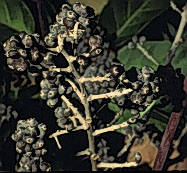
Schefflera morototoni
(Aubl.) Maguire, Steyern. & Frodin
(Araliaceae)
|
Schefflera morototoni (Aubl.) Maguire, Steyern. & Frodin (Araliaceae) | |
Espinoza, R., Masís, A., Chavarría, F., Guadamuz, A. y Perez, D. 1998. Schefflera morototoni Species Page (Araliaceae), 11 february 1998. Species Home Pages, Area de Conservación Guanacaste, Costa Rica. http://www.acguanacaste.ac.cr
Tree up to 15 m tall, with an erect trunk.
Flower:
The inflorescens are umbels arranged that come out of a terminal panicle.
Fruit:
Purple berries, flattened laterally, 7 mm in lenght. Each fruit has two seeds that are dispersed by animals.
 | |
Infrutescens | |
Leafs:
Leafs are palmately compound and the number of leaflets varies between 8-11. Upperside is dark green while the underside is light brown.
|
Upper surface |
Under surface |
|
Petiolules | |
Leaflets are lanceolate with the margin entire. The whole leaf is about 40-95 cm in lenght. Leaflets are 8-35 cm in lenght.
|
Leaflet |
The petiole is cilindrical and aproximately 56 cm in lenght. It has a well developed ligule.
|
Petioles |
Bark and wood:
The bark is light brown and the wood is cream color.
|
Bark |
Internal bark |
Whole plant achitecture:
Young tree | |
|
Trunk | |
Similar species:
It is the only species of Schefflera in the dry semi-deciduos forest. Schefflera siebertii A.C Smith is found the humid forests. Its a shrub up to 5 m tall (Cannon & Cannon 1989).
It can be confused because of its leafs with other palmately compound species like Tabebuia (Bignoniaceae), but the petiole in Schefflera morototoni is much longer and the lamina has more leaflets than the species of Tabebuia which usually have 5. Floristicly they are very different, Tabebuia flowers are campanulate and conspicuous (yellow, pink, lavander). Tabebuia fruits are dehiscent pods with winged wind dispersed seeds.
Its possible also to mistake Schefflera morototoni leafs with Cecropia sp leafs. But Cecropia are simple leafs that ara PENTADAMENTE LOBULADAS (TRANSLATION PLEASE), In other words, Cecropia does not have leaflets.
Verification:
There is a voucher REspinoza 1727 at INBio and another REspinoza 160 at the National Musuem.
The old name for this species is Didyopanax morototoni (Aubl) Decne & Planch.
II.Geographic distribution:
International:
México to Panamá. (Cannon &Cannon 1989).
In Costa Rica:
Vertiente del Pacífico. PACIFIC WATERSHED?????.
In the Area de Conservación Guanacaste:
It is the only Schefflera species that grows in the dry semi-deciduous forest.
Map of macro-habitats of the
ACG |
III. Natural history:
IV. How to find:
It can be found in the trails in Sector El Hacha, near Los Almendros station.
Acknowledgments:
This project was carried out by the Area de Conservación Guanacaste/CR, with help from INBio/CR, ICBG from the Foggarty center, NIH/USA and NSF/USA.
Literature cited:
Cannon, M. J. & Cannon, J. F. M. 1989. Central American Araliaceae - a precursory study for the
Flora Mesoamericana. Bull. Br. Mus. nat. Hist. (Bot.) 19:5-61.